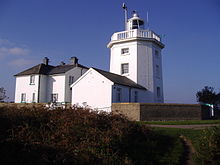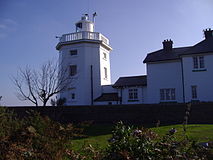- Cromer Lighthouse
-
Cromer Lighthouse Cromer Lighthouse Location Cromer, Norfolk, England Coordinates 52°55.45′N 01°19.10′E / 52.92417°N 1.3183°E Year first lit 1st 1680 2nd 1833 Automated 1990 Construction Masonry Tower shape Octaganal Height 18 Metres, Focal height 84 Metres above mean high water Range 23 nmi (43 km) Characteristic 1 flash every 5 seconds Cromer Lighthouse situated in the town of Cromer on the coast in the English county of Norfolk.
Contents
History
There has been a lighthouse on the cliff top at Foulness, east of the town of Cromer since 1669. Before this time a light was shone from the top of Cromer parish church to act as a guide to passing shipping. Although this light was small it had always been useful, as had many similar ecclesiastical lights that were dotted around the coastline of Great Britain from medieval times.
New proposals
It was a man called Sir John Clayton who put forward the proposal for a lighthouse at Foulness, Cromer along with five other lighthouses on four different sites. As well as Cromer, His plan was to place lights at the Farne Islands off Northumberland, Flamborough Head in Yorkshire and Corton close to Lowestoft in Suffolk. In 1669 Clayton along with his partner George Blake received the comprehensive patent for the four sites and work began to erect the lighthouses. each tower had cost the men £3,000[1] and their patent would last for 60 years with specified rates due to be paid to partners by the owners of passing vessels, although dues were only paid voluntarily.
Difficult times
The cost of maintaining the lighthouse proved to be very high and this, plus reluctance on the part of ship-owners to part with their voluntary payments lead to a situation were Clayton and Blake could not afford to keep the fire kindled at the top of the Cromer tower. Nevertheless the Cromer Lighthouse was still of some use as a beacon and was marked on Admiralty charts as “a lighthouse but no fire kept in it”. With the Clayton tower falling into disrepair, the owner of the land at Foulness, Nathaniel Life, was convinced that a Lighthouse repaired and maintained was essential at the site. In 1719 a new patent was granted. Dues were set to shipping at the rate of a farthing per ton of general cargo and a halfpenny per chaldron (25 cwt) of Newcastle coal. Nathaniel Life and Edward Bowell jointly received a 61 year lease from Trinity House at a rental of £100 on the undertaking that Nathaniel Life would pass the lighthouse plus one acre of land in to the ownership of Trinity House at the end of the 61 years. The lighthouse now maintained a coal fire enclosed in the Lantern.
Trinity House
In 1792 Cromer Lighthouse was in the possession of Trinity House and was fitted with a second flashing light, five reflectors and Argand oil fired lamps on three sides of the revolving frame. Aimé Argand[2] had perfected his cylindrical wick lamp which provided a central current of air through the burner, thus allowing the more perfect combustion of the gas issuing from the wick. Sperm oil, costing 5s. to 8s. per gallon, was used in Cromer lighthouse This new and recurrent and rapid obscureness[clarification needed] of the light was a constant bugbear for some seamen. The first keepers of the Cromer Lighthouse were two young women who jointly received a pound a week for their wage. The lighthouse's position at Foulness was becoming precarious due to rapid cliff erosion along this part of the North Norfolk coast. The sea's encroachment at the base of the cliff caused several land slips with serious slides recorded in 1799, 1825 and 1852.[1] The lighthouse succumbed to the waves' actions in 1866 when it finally slipped down into the sea.
The present lighthouse
With the expected destruction of the old lighthouse plans to build a new lighthouse had been put into place long before the loss of 1866. The present lighthouse was built half of a mile from the cliff edge and came into operation in 1833. It is constructed of masonry and the tower is octagonal in shape and is 59 feet (18 m) tall. Electricity was installed in 1958 to power the light. The Light is 275 feet (84 m) above sea level. In June 1990 the lighthouse was converted to automatic operation and is monitored from the Trinity House Operation Control Centre at Harwich in Suffolk. As a consequence of automation the lighthouse keeper's cottage alongside the tower is now let out as holiday apartment although the property is still owned by Trinity House. The lighthouse tower is not open to the public but the area around the lighthouse is easily accessible.
References
- ^ a b Trinity House
- ^ Wolfe, John J. Brandy, Balloons, & Lamps: Ami Argand, 1750-1803 ISBN 0-8093-2278-1
Categories:- Buildings and structures in Norfolk
- Lighthouses in England
- Geography of Norfolk
- North Norfolk
- Coastal feature of Norfolk
Wikimedia Foundation. 2010.


